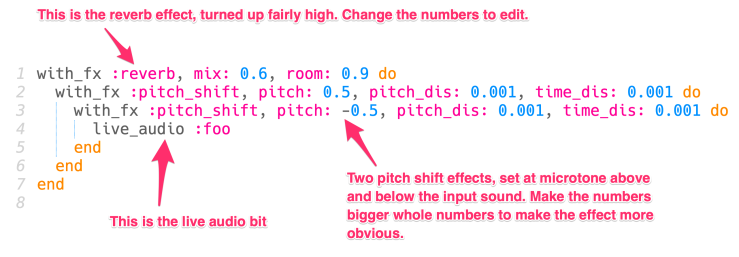A quick idea – Saariaho Set Work and Sonic Pi
This is an old post from my old blog, but I think it is still relevant…
I think, I hope, that I’ve created simple and effective resource that goes some way to helping students engage in the Kaija Saariaho set work (Edexcel A Level Music).
Essentially it takes live sound as an input, and adds reverb and harmoniser effects akin to those in Petals, the set work. I’ve attempted to annotate the code below:

There are a few things to note:
- You need to set your inputs and outputs up in Sonic Pi. It’s easy to do. It does work with laptop speakers and mic, but feedback is a problem. An audio interface with monitors is preferable (though feedback can still occur).
- As mentioned in the picture, the harmoniser effect is subtle. Changing the numbers to other whole numbers adds more discernible intervals.
- The effect doesn’t change over time like the Saariaho effects. If you can, change the dry/wet mix on your interface to create a ‘Saariaho-like effect’.
Though it seems complicated, essentially all you need to do need to do is open the code in Sonic Pi, run the code, and play an instrument. It does work!
All I do is set up a mic, and get students to come and play their instruments. They can play long and short notes, explore their range, as well as extended techniques. Any sound will work. They then hear the ‘processed’ sound live.
My students enjoyed this, and it helped them understand how the electronics were changing the sound of the ‘cello in the Saariaho set work. Feel free to use my little piece of code, and ask any questions if you need help setting it up. I hope it is useful!
-DG